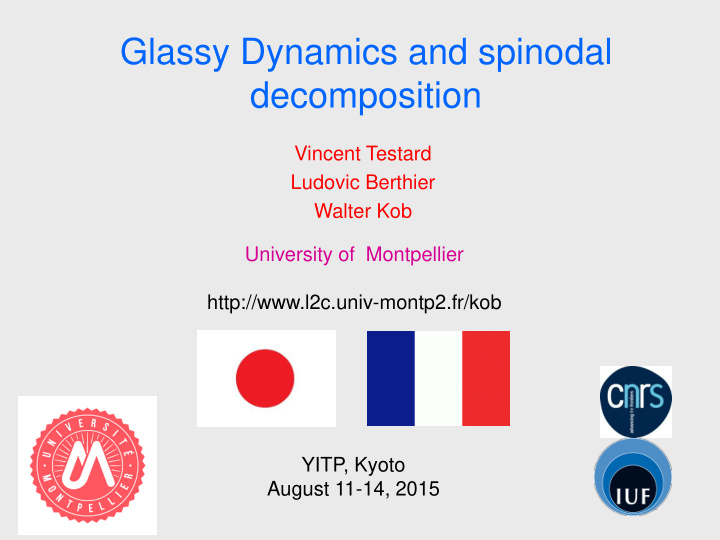



Glassy Dynamics and spinodal decomposition Vincent Testard Ludovic Berthier Walter Kob University of Montpellier http://www.l2c.univ-montp2.fr/kob YITP, Kyoto August 11-14, 2015 1
The glass transition • If in an experiment (or simulation) one wants to investigate the properties of a system at a given T, one first has to bring the system to this temperature (by coupling it to a heat bath) • If one wants to study the equilibrium dynamics one will have to allow the system to equilibrate and usually this takes a time that is comparable with the relaxation time of the system • Due to the strong increase of with decreasing T there will exist a temp. T at which the system falls out of equilibrium (because we don’t have enough patience) and forms a glass the sys ystem tem undergo dergoes es a g glas ass s transi ansition ion N.B.: The temperature of this glass transition and the properties of the glass depend depends on the 2 experiment
On gels (as seen by Google) • disordered structure (=glass) • structure is open (not like dense glasses) • often soft • complex rheological properties • often produces via a chemical reaction (e.g. vulcanization) or… 3
Producing gels via spinodal decomposition Phase diagram of a liquid ? Experiments: • What happens with the spinodal • Cardinaux et al. PRL 2007 decomposition at low T’s? • Lu et al. Nature (2008) • What happens when the glass-transition line 4 meets the binodal?
Our Glass-former (=Sample) • Binary mixture of Lennard-Jones particles (model for Ni 80 P 20 , a metalic glass-former) Parameters: AA = 1.0 AB = 1.5 BB = 0.5 AA = 1.0 AB = 0.8 BB = 0.88 • System size: N=8000, 49000, 300000, 10 6 5
Phase diagram • spinodal has been calculated by Sasty (PRL 2000) • binodal is determined by p=0 simulations/quenches to low T’s • glass transition line = Vogel-Fulcher line (Berthier et al. PRE 2010) 6
Configuration after a fixed, large time 7
Energy of the system Look at potential energy as a function of time (after the quench) • At intermediate temperatures E p decreases with T • At low T, E p increases with decreasing T Competition between driving force and greediness 8
Total surface of the interface Look at surface of G-L interface as a function of time • Non-monotonic t-dependence of Surface(t) • At long times Surface(t) increases with decreasing T 9 (structure becomes more spongy)
Static structure factor Experiments usually consider the first peak in the static structure factor to characterize the size of the domains • Even for large systems (N=300k) it is hard to extract from S(q,t) a length scale at long times 10
Chord length distribution Define chords chord length l (for the liquid and the gas); P. Levitz • Distribution P(l,t) • P(l,t) is at intermediate l given by an exponential • Peak at large l is finite size effect 11 • Use first moment of P(l,t) to define a length scale L
Time dependence of chord length distribution • For all t the shape of P(l,t) is the same definition of length scale L(t) via integral of P(l,t) is reasonable • Peak at large l is finite size effect, but is under control 12
Chord length distribution Compare L(t) with length obtained from S(q,t): 2 /q max • The two definitions give the same result • lLquid and gas chord length show the same time dependence 13
Growth of length scale • Spinodal decomposition: growth of length depends on model (type of order parameter), dynamics, theory,... • Usually L(t) t with =1/3 (Kawasaki), 1/2 (Glauber), 1.0,... • not clear whether • Not clear whether power-laws give a power-laws give a good description of good description of growth. growth. •At low T’s we rather •At low T’s we rather see logarithmic growth see logarithmic growth; relation to visco-elastic effects? 14
Relaxation mechanism • How do the particles move during the spinodal decomposition? Look at a growth of fixed length scale : L L + 15
Relaxation mechanism 2 Displacement field of the fastest 3% of particles T=0.5 ; 0 = 0.4 T=0.1 ; 0 = 0.4 Relaxation is quite homogeneous Relaxation is very heterogeneous 16
Relaxation mechanism 3 How do at low T and long times the particles relax? t=1300 t=2300 t=50 t=10000 t=2100 t=1100 • Arms are stretched and broken like in a very viscous fluid • Relaxation of surface extremely slow surface tension is no 17 longer relevant
Summary • Simulations of liquid-gas spinodal decomposition of a simple glass former • For simulations static structure factor is not very helpful to characterize length scales use chord length distribution • At low T’s the time dependence of domain growth is very complex and not described by usual spinodal decomposition theories; need to include visco-elastic effects • At low T’s the relaxation events are very localized in space and time driving force for relaxation is the stored stress in the sample Reference: V. Testard, L. Berthier, and W. Kob, Phys. Rev. Lett. 106 , 125702 (2011); VT, LB, and WK, J. Chem. Phys. 140 , 164502 (2014). 18
Recommend
More recommend